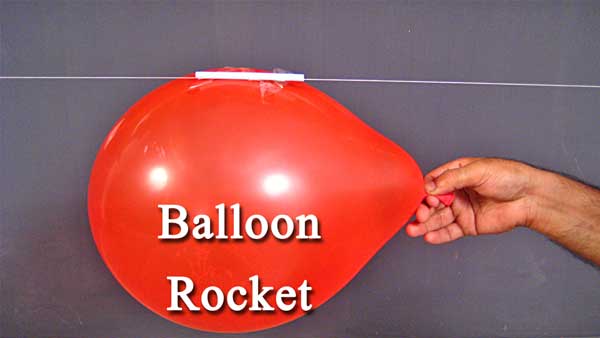Balloon rocket making is a great fun science project for kids and a wonderful way to let them understand Newton’s 2nd and 3rd law.
Your kids can easily make this balloon rocket without any skills and without any major assistance of adults.
Material Required to Make Balloon Rocket
- Balloon : 1
- Balloon Inflation Pump : 1
- Kite String : 25 feet long
- Straw : 1
- Adhesive Tape : 1
Balloon Rocket Making Procedure : Video
Watch my following video to learn how to make balloon rocket.
Balloon Rocket Making Procedure : Step-by-Step Instructions
1. Cut a 3 inch long piece from a straw you used for cold drinks.
2. Pass one end of the kite string through it.
3. Tie this end of kite string to any chair, door or window.
4. Tie another end of string at 25 feet distant object, i.e. another chair, door, tree, window at horizontal level or at some height so that your balloon rocket can propel at slant height. Remember, your kite string must remain tight after tying both the ends.
5. Now blow your balloon.
6. Hold your balloon’s mouth closed between your finger and thumb so that the air of balloon should not release. But don’t tie the mouth of the balloon.
7. Fix your blown balloon with straw at 2 or 3 places with the help of adhesive tape.
8. Leave the balloon and it will propel as a rocket on string.
Science Behind Balloon Rocket
As per Newton’s second and third law, when a body (or system) expels or accelerates mass in one direction, the accelerated mass will cause a force of equal magnitude but in opposite direction on that system. The force applied on a surface in a direction perpendicular or normal to the surface is called thrust.
When you released the blown balloon, the air came out with some force from the balloon’s mouth towards you. It caused a force on balloon which was equal in magnitude but in opposite direction (from balloon’s mouth to balloon’s head). This force propelled the balloon in forward direction.
Straw and kite string were used only to maintain the track of balloon rocket.
Now you can repeat this experiment with some changes, i.e. blow same balloon more or less, use different sized balloons etc. You will notice the difference in force in terms of propulsion speed of balloon rocket in each case. This happens due to the Newton’s second law which says, “Force is equal to the multiplication of mass and acceleration”, i.e. F = ma.
The amount of the air you blow in the balloon is mass (m) in this formula F = ma. Speed of your balloon rocket hence varies when you use balloons of different sizes or you blow your same balloon less or more.
You can also try the experiment of your balloon rocket with different values of acceleration (a) rather than the different values of mass of air (m). If you tie the mouth of your blown balloon and fix it with straw with the help of adhesive tape and release the balloon from your hands, what will happen?
Certainly, no air will come out from the balloon. It means the acceleration (a) in F = ma is zero, hence the result of “m” multiplied by “a” is zero, and the force F is also zero. So the balloon rocket will not propel.
Now pinch a tiny hole at the neck of the balloon with a pin. This time air will come out from the balloon with slow acceleration in comparison of the first case when you released the entire mouth of balloon opened. And hence, you will get the slow propulsion of your balloon rocket.

